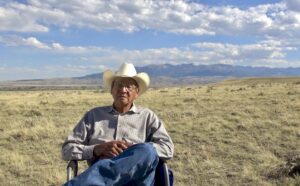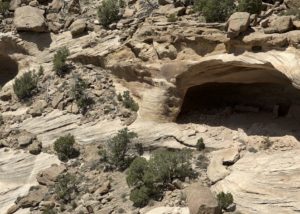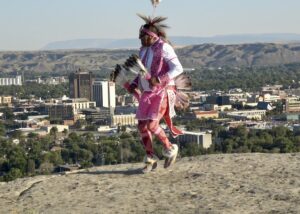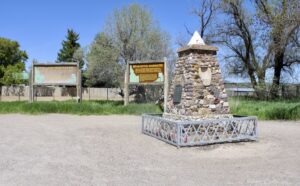Dubois POW Camp
Around 425,000 POWs were brought to the United States during WWII at the request of the British government. Most were German, though Italian prisoners also arrived by boat to processing centers located in New York and Virginia. There were 700 German POW camps in all, mostly located in rural areas deemed to be low security risks. Prisoners throughout the country worked in mills, canneries and on farms
In Wyoming, most of its 19 POW camps replaced agricultural laborers, as there was a critical shortage of farm workers with so many soldiers sent overseas. Four of Wyoming’s camps provided labor for the forest industry.
Between 1914 and 1946, timber workers living in “tie-camps” – located in the rugged mountains above the remote town of Dubois in northwest Wyoming – produced over 10 million railroad ties for the nation’s railroads. Initially ties were hand-hewn during the winter months. By the 1930s portable sawmills replaced the broad axes. Logs were hauled and stacked along tributaries of the Wind River. More remote areas relied on an elaborate system of water filled flumes – some hanging from the sides of steep canyon walls – to transport the logs to the river. At the height of the spring runoff the ties were put into the water. Floated downstream in ‘river drives’ to the tie-yards in Riverton, they traveled about 100 miles, guided along the way by tie-drivers. At the height of the industry over 800,000 logs made the annual trip to the creosote yards. The last tie-drive, held in 1946, carried 150,000 ties. While the majority of those who worked in the tie industry were Scandinavian immigrants, timber workers included Shoshone and Arapahos and towards the end of the WWII, German POWs.
Located in the Shoshone National Forest, the prisoners at Camp Dubois became tie-hacks. Brought to the Wind River Mountains in 1944, POWs lived in a compound of walled tents. Local author Cheryl O’Brien and retired forester Bob Baker recount the little-known history of this camp. Now largely overtaken by brush and trees, Camp Dubois played a fascinating – if little known – part in the history of WWII and Wyoming.
Poems and other writings by the German POWs held at Camp Dubois document the prisoners’ thoughts and the more personal aspects of their experiences of their time in the mountains high above Dubois.
Several escape attempts from Wyoming POW camps were recorded, notably at Camp Douglas and Camp Warren. One attempt, passed down by word of mouth from Camp Dubois but missing from official records, told of a POW who got turned around in the snow-covered forests after escaping from camp. He apparently decided to return to the safety of his fellow inmates after assessing the risks of getting lost in Wyoming’s winter wilderness. With electricity, hot meals, and relatively congenial relationships with the enlisted men that guarded them, as well as the locals they worked with, Camp Dubois was not a bad place in which to wait out the war.






